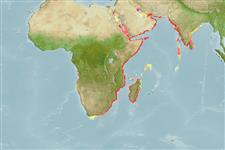Actinopterygii (peixes com raios nas barbatanas) >
Clupeiformes (Herrings) >
Engraulidae (Anchovies) > Coiliinae
Etymology: Thryssa: Greek, thrissa, -es = shad (Ref. 45335).
Ambiente / Clima / Intervalo
Ecologia
; marinhas; estuarina; intervalo de profundidade 0 - 50 m (Ref. 189). Tropical, preferred ?; 31°N - 40°S, 20°W - 88°E (Ref. 189)
Indian Ocean: Madagascar, coasts of Africa from Port Alfred northward to the Persian Gulf but not in the Red Sea, coasts of Pakistan and India, perhaps to Calcutta and off Myanmar, but no records.
Tamanho / Peso / Idade
Maturity: Lm ? range ? - ? cm
Max length : 20.0 cm TL macho/indeterminado; (Ref. 5430)
Espinhos dorsais (total): 0; Espinhos anais 0; Raios anais moles: 31 - 40. Belly with 16 to 19 + 8 t0 12 = 24 to 30 keeled scutes from isthmus to anus. Maxilla long, reaching beyond base of first pectoral fin ray; minute, oval first supra-maxilla. Lower gill rakers with serrae on the inner edge in distinct clumps in larger fishes. A dark blotch behind upper part of gill opening; inside of gill cavity bright orange.
Coastal pelagic (Ref. 68964). Presumably schooling, occurring inshore and entering estuaries and lagoons (perhaps as nursery areas), but moving further out in rainy seasons when coastal waters are freshened up by rivers. May be caught using ringnets (Ref. 5213). Generally marketed fresh, may be salted or dried (Ref. 5284).
Life cycle and mating behavior
Maturidade | Reprodução | Desova | Ovos | Fecundidade | Larvas
Whitehead, P.J.P., G.J. Nelson and T. Wongratana, 1988. FAO Species Catalogue. Vol. 7. Clupeoid fishes of the world (Suborder Clupeoidei). An annotated and illustrated catalogue of the herrings, sardines, pilchards, sprats, shads, anchovies and wolf-herrings. FAO Fish. Synop. 125(7/2):305-579. Rome: FAO. (Ref. 189)
Categoria na Lista Vermelha da IUCN (Ref. 115185)
CITES (Ref. 94142)
Not Evaluated
Ameaça para o homem
Harmless
Utilização humana
Pescarias: pouco comercial; isco: usually
Mais informação
ReferênciasAquaculturaPerfil para aquaculturaEstirpesGenéticaFrequência dos alelosHereditariedadeDoençasProcessamentoMass conversion
ColaboradoresFotografiasStamps, CoinsSonsCiguateraVelocidadeTipo de nataçãoÁrea branquialOutras referênciasCérebrosVisão
Ferramentas
Relatórios especiais
Descarregue XML
Fontes da internet
